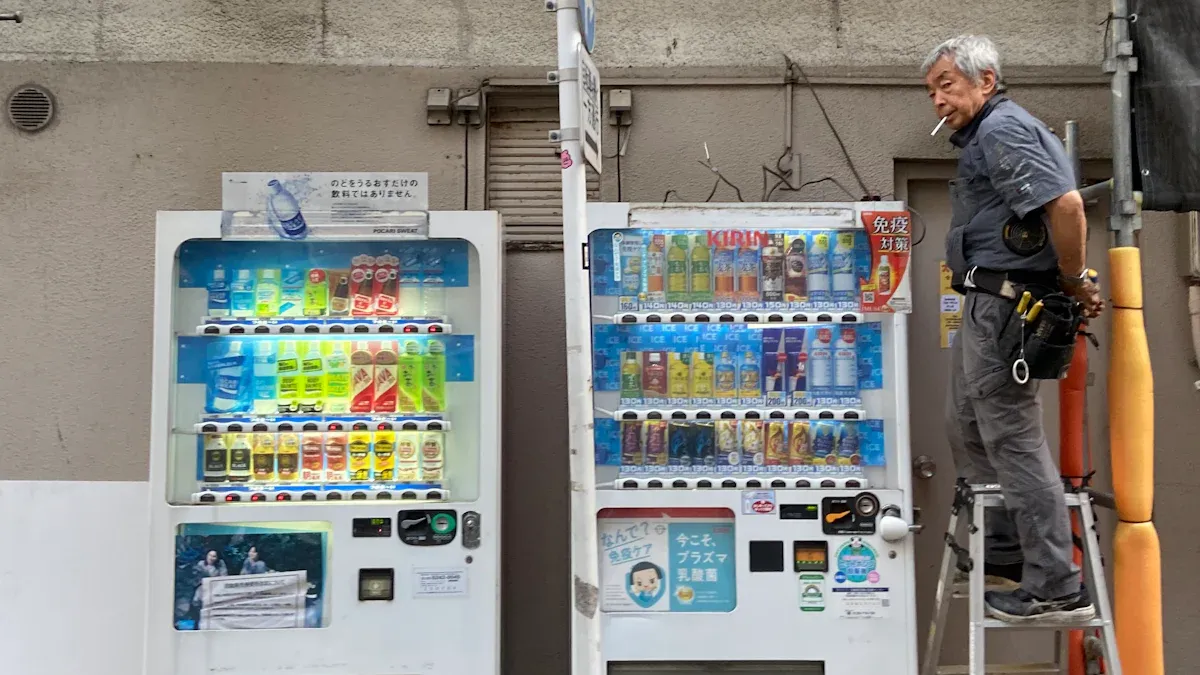Effective Methods to Safely Remove Rust from Vending Machines

Rust can significantly shorten the lifespan of vending machines. It weakens the metal, making components less durable. You may notice that rust also impacts the machine's appearance, reducing its appeal to customers. When you remove rust promptly, you ensure the machine functions safely and efficiently. Advanced solutions like Cloudpick's Unmanned Store use rust-resistant materials to enhance durability.
Key Takeaways
Clean often to stop rust. Stick to a regular plan to keep vending machines working well.
Use natural items like baking soda and vinegar to clean rust. These are safe ways to care for your machines.
Try Cloudpick's Unmanned Store for rust-proof designs. This helps reduce upkeep and makes your vending machines last longer.
Understanding Why Rust Forms on Vending Machines
Common causes of rust
Rust forms when iron or steel reacts with oxygen and moisture. This process, called oxidation, happens more quickly in environments with high humidity or frequent exposure to water. If your vending machine is placed outdoors, rain or dew can accelerate rust formation. Even indoor machines are not immune. Spilled drinks or condensation from temperature changes can create the perfect conditions for rust to develop.
Environmental factors also play a role. Coastal areas with salty air or regions with heavy pollution can speed up the rusting process. Over time, these elements weaken the metal surfaces of your vending machine, making them more prone to damage.
Effects of rust on vending machine performance and appearance
Rust doesn’t just affect how your vending machine looks; it also impacts its functionality. Corroded parts can jam or break, leading to mechanical failures. For example, rusted hinges or locks may prevent doors from opening smoothly. This can frustrate customers and disrupt your business operations.
The appearance of rust can also deter potential users. A vending machine covered in rust looks neglected and unclean. Customers may question the quality of the products inside. Addressing rust promptly ensures your machine remains reliable and visually appealing.
Safe and Effective Methods to Remove Rust

Using natural solutions like baking soda, vinegar, and lemon juice
You can use natural solutions to remove rust effectively and safely. Baking soda works well for small rust spots. Mix it with water to form a paste, then apply it to the affected area. Scrub gently with a brush and rinse thoroughly. Vinegar is another excellent option. Soak a cloth in white vinegar and place it on the rusted surface for a few hours. Afterward, scrub the area and wipe it clean. Lemon juice, combined with salt, also helps. Sprinkle salt on the rust, squeeze lemon juice over it, and let it sit. Scrub the surface and rinse it off for a clean finish.
Electrolysis as a safe rust removal method
Electrolysis offers a chemical-free way to remove rust from vending machines. This method uses an electric current to break down rust. You’ll need a container, water, washing soda, and a power source. Submerge the rusted part in the solution and connect it to the power source. The rust will detach from the metal, leaving it clean. This method is ideal for intricate parts that are hard to clean manually.
Commercial rust removers and their benefits for vending machines
Commercial rust removers provide a quick and efficient solution. These products are designed to dissolve rust without damaging the metal. The market for metal cleaners shows their effectiveness, as federal agencies use them to maintain equipment. Many products meet strict performance standards, ensuring reliable results. For vending machines, these removers save time and restore the machine’s appearance and functionality.
How Cloudpick's Unmanned Store integrates rust-resistant materials
Cloudpick’s Unmanned Store uses advanced materials to prevent rust formation. The store’s design incorporates rust-resistant metals and coatings, ensuring durability in various environments. This innovation reduces maintenance needs and extends the lifespan of the machines. By choosing Cloudpick’s solutions, you benefit from cutting-edge technology that minimizes rust-related issues.
Step-by-Step Guide to Rust Removal
Tools and materials needed for each method
To remove rust effectively, you’ll need specific tools and materials. For natural solutions, gather baking soda, vinegar, lemon juice, salt, and a soft-bristle brush. If you’re using electrolysis, prepare a container, water, washing soda, and a power source. For commercial rust removers, keep gloves, a sponge, and a clean cloth handy. Sandpaper, steel wool, and a wire brush are essential for stubborn rust spots. Always have old rags for drying and a protective spray like WD-40 to prevent future rust.
Precautions to ensure safety during the rust removal process
Safety should always come first when removing rust. Wear gloves to protect your hands from chemicals or sharp edges. Use goggles to shield your eyes from debris while sanding or scrubbing. Work in a well-ventilated area, especially when using commercial rust removers or electrolysis. Keep electrical equipment away from water to avoid accidents. If you’re sanding, wear a mask to prevent inhaling dust particles. Always read product labels and follow instructions carefully.
Detailed steps for applying each method effectively
Natural Solutions: Apply a paste of baking soda and water to the rusted area. Scrub gently with a brush, rinse, and dry. For vinegar, soak a cloth in it and place it on the rust. After a few hours, scrub and wipe clean. Lemon juice works similarly—sprinkle salt on the rust, add lemon juice, let it sit, scrub, and rinse.
Electrolysis: Fill a container with water and mix in washing soda. Submerge the rusted part and connect it to a power source. The rust will detach from the metal. Rinse and dry the piece thoroughly.
Sanding and Sealing: Use coarse sandpaper or a wire brush to remove heavy rust. Progress to finer grits until the metal regains its original color. Wipe the surface with a vinegar-soaked rag, dry it, and repeat if necessary. Finish by spraying WD-40 or applying a light oil to protect the surface.
Tip: After removing rust, seal wooden parts with varnish or polyurethane to prevent moisture damage.
Tips for Preventing Rust in Vending Machines

Regular cleaning and maintenance practices
Regular cleaning is essential to prevent rust and maintain the efficiency of vending machines. Dirt, moisture, and spills can create the perfect environment for rust to form. Following a consistent cleaning schedule ensures your machine stays in top condition.
Frequency | Purpose | |
|---|---|---|
Daily Wipe-Downs | Daily | Remove fingerprints, dirt, and dust from the machine’s surface. |
Sanitize High-Touch Areas | Daily | Prevent germ transmission on buttons, payment systems, and trays. |
Weekly Cleaning | Weekly | Ensure product freshness and machine efficiency. |
Inspect for Spills | Weekly | Deter pests and maintain hygiene. |
Deep Clean of Product Compartments | Monthly | Inspect for signs of mold or pests and ensure cleanliness. |

Protective coatings and rust inhibitors
Applying protective coatings or rust inhibitors can shield metal surfaces from moisture. Products like clear sprays or specialized paints create a barrier that prevents oxidation. These coatings are especially useful for vending machines placed in humid or outdoor environments.
Proper placement and storage of vending machines
Where you place your vending machine matters. Avoid areas with high humidity, direct exposure to rain, or salty air. Indoors, ensure proper ventilation to reduce condensation. If storing machines for long periods, cover them with waterproof materials to protect against moisture.
Leveraging Cloudpick's Unmanned Store for advanced rust prevention
Cloudpick’s Unmanned Store uses rust-resistant materials and advanced coatings to minimize maintenance needs. These innovative designs ensure durability, even in challenging environments. By choosing this solution, you reduce the risk of rust and extend the lifespan of your vending machines.
The Role of a Comprehensive Kit for Vending Machines
Essential tools and materials for maintaining vending machines
Maintaining vending machines requires a well-prepared kit to ensure smooth operations. You need tools and materials that address cleaning, repairs, and rust prevention. Here are some essentials:
Cleaning Supplies: Include microfiber cloths, mild detergents, and sanitizing sprays to keep surfaces spotless.
Rust Removal Tools: Stock items like baking soda, vinegar, and commercial rust removers for tackling corrosion.
Basic Repair Tools: Keep screwdrivers, pliers, and wrenches handy for quick fixes.
Protective Coatings: Use rust inhibitors or clear sprays to shield metal parts from moisture.
Monitoring Devices: Equip yourself with a thermometer to check temperature settings for perishable items.
Tool/Material | Description | Purpose |
|---|---|---|
Vending Machine Portal | Offers detailed descriptions and technical specifications for industrial products. | Helps select suitable tools and materials. |
Real-time Stock Updates | Enables checking availability of supplies before selection. | Minimizes delays in maintenance. |
Mobile Compatibility | Allows access to supplies from smartphones or tablets. | Facilitates management during maintenance. |
These tools ensure your vending machines remain functional and visually appealing.
How to assemble a rust removal and maintenance kit
Creating a comprehensive kit vending machines need for maintenance is simple. Start by categorizing items based on their purpose. For cleaning, include cloths, sprays, and detergents. Add rust removal tools like baking soda, vinegar, and a wire brush. For repairs, pack screwdrivers, pliers, and spare parts. Don’t forget protective gear like gloves and goggles for safety.
To make your kit more efficient, consider these tips:
Restock Regularly: Check and replenish supplies to avoid running out during emergencies.
Use Airtight Packaging: Store items like rust removers in sealed containers to prevent spills.
Monitor Inventory: Implement a first-in, first-out (FIFO) system to keep products fresh.
A well-organized kit saves time and ensures your vending machines operate without interruptions.
Addressing rust promptly ensures your vending machines remain functional and visually appealing. You’ve learned effective methods like natural solutions, electrolysis, and commercial rust removers. Preventive measures, including regular cleaning and protective coatings, further safeguard your machines.
Tip: Explore Cloudpick’s Unmanned Store for rust-resistant designs that reduce maintenance and extend machine lifespan.
FAQ
What is the best way to prevent rust on vending machines?
Regular cleaning and applying protective coatings work best. Keep the machine in a dry, ventilated area to minimize moisture exposure.
Can I use household items to remove rust?
Yes! Baking soda, vinegar, and lemon juice effectively remove rust. These natural solutions are safe and easy to use.
How does Cloudpick’s Unmanned Store help with rust prevention?
Cloudpick’s Unmanned Store uses rust-resistant materials and advanced coatings. This design reduces maintenance and extends the machine’s lifespan.
See Also
Key Maintenance Strategies for Vending Machine Security Features
Calculating the Expense of Explosives for Vending Machine Heists
The Role of Vending Machines in Fast Food Innovation
